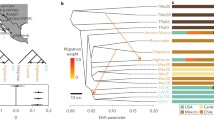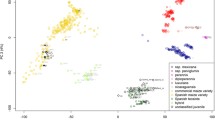Summary
The tripartite hypothesis postulates that cultivated maize was derived from a wild podcorn which was once indigenous to the lowlands of South America; that this wild Z. mays is now extinct; that Z. mexicana (teosinte) originated from natural hybridization of Z. mays and a species of Tripsacum after cultivated maize was introduced into Central America; and that most modern races of maize resulted from introgression of primitive maize with teosinte, Tripsacum, or both. This hypothesis has been criticized primarily on the basis that it involves too many theories for the available facts.
The basic question that needs to be answered is whether maize was domesticated from a wild Z. mays or from Z. mexicana. The oldest known archaeological remains suggest that a wild Z. mays existed before Z. mexicana came on the scene. This question can only be settled by further archaeological research.
Accepting the assumption that a species of Zea which is distinctly different from Z. mexicana gave rise to maize, however, does not necessarily lead to accepting a hybrid origin for teosinte. Judging from present day breeding behaviour, Z. mays and Z. mexicina are conspecific and only distantly related to Tripsacum. This cytogenetic similarity could be explained on the basis of extensive introgression between teosinte and maize. Introgression of germplasm from teosinte into maize is obvious wherever these taxa are sympatric. This pattern of a crop absorbing genes of its wild progenitor across a weedy race, is commonly encountered in all other cereals. Should this not be true in maize, it certainly will be a rare exception.
The assumption that teosinte originated as a hybrid between domesticated Z. mays and a species of Tripsacum remains an intriguing possibility. However, after weighing the pros and cons of the available morphological and genetical evidence, the level of confidence with which this hypothesis can be excepted appears rather low.
Similar content being viewed by others
References
Anderson E. & Erickson R. O., 1941. Antethetical dominance in North American maize. Proc. Natn. Acad. Sci. 27:436–440.
Barghoorn E., Wolfe M. K. & Clisby K. H., 1954. Fossil maize from the Valley of Mexico. Bot. Mus. Leafl. Harv. Univ. 16:229–240.
Beadle G. W., 1932. The relation of crossing over to chromosome association in Zea-Euchlaena hybrids. Genetics 17:481–501.
Brown W. L., 1949. Number and distribution of chromosome knobs in United States maize. Genetics 34:524–536.
Chaganti, R. S. K., 1965. Cytogenetic studies of Maize-Tripsacum hybrids and their derivaties. Ph. D. thesis, Bussey Inst. Harvard Univ. Publ., Cambridge.
Collins G. N. & Kempton J. H. 1914. A hybrid between Tripsacum and Euchlaena. J. Wash. Acad. Sci. 4:114–117.
Collins G. N. & Kempton J. H., 1916. Parthenogenesis. J. Hered. 7:106–118.
Cutler H. C. & Anderson E., 1941. A preliminary survey of the genus Tripsacum. Ann. Mo. Bot. Gdn. 28:249–269.
Wet de J. M. J., Lambert R. J., Harlan J. R. & Naik S. N., 1970. Stable triploid hybrids among Zea-Tripsacum-Zea backcross populations. Caryologia 23:183–187.
Emerson R. A. & Beadle G. W., 1930. A fertile tetraploid hybrid between Euchlaena perennis and Zea mays. Am. Nat. 64:304–315.
Farquharson L. I., 1957. Hybridization of Tripsacum and Zea. J. Hered. 48:295–299.
Galinat W. C., 1963. Form and function of plant structures in the American Maydeae and their significance for breeding. Econ. Bot. 17:51–59.
Galinat, W. C., 1970. The cupule and its role in the origin and evolution of maize. Agric. Exp. Stn Univ. Mass. Bull. No. 585.
Galinat W. C., Chaganti R. S. K. & Hager F. D., 1964. Tripsacum as a possible amphidiploid of wild maize and Manisuris. Bot. Mus. Leafl. Harv. Univ. 20:289–316.
Harlan J. R., Wet J. M. J. de, Naik S. M. & Lambert R. J., 1970. Chromosome pairing within genomes in Maize X Tripsacum hybrids. Science 167:1247–1248.
Hernandez, X. E. & Randolph, L. F., 1950. Decripcion de los Tripsacum diploides de Mexico; Tripsacum maizar y Tripsacum zopilotense. Spp. Nov. Ofic. Estud. Esp. SAG. Fol. Tec. No. 4.
Hitchcock A. S., 1922. A perennial species of teosinte. J. Wash. Acad. Sci. 12:205–208.
Hitchcock. A. S., 1950. Manual of the grasses of the United States. U.S. Dept. Agric. Misc. Publ. 200.
Irwin H. & Barghoorn E. S., 1965. Identification of the pollen of maize, teosinte and Tripsacum by phase contrast microscopy. Bot. Mus. Leafl. Harv. Univ. 21:37–57.
Longley A. E., 1934. Chromosomes in hybrids between Euchlaena perennis and Zea mays. J. Agric. Res. 48:789–806.
Longley A. E., 1941. Chromosome morphology in maize and its relatives. Bot. Rev. 7:262–289.
Longley A. E., 1952. Chromosome morphology in maize and its relatives. Bot. Rev. 18:399–412.
Longley A. E. & Kato T. A., 1965. Chromosome morphology of certain races of maize in Latin America. Int. Center for Imp. Maize and Wheat, Chapingo, Mexico, Res. Bull. 1.
Maguire M. P., 1957. A study of homology between a terminal portion of Zea chromosome 2 and a segment derived from Tripsacum. Genetics 45:195–209.
Maguire M. P., 1960. A study of pachytene chromosome pairing in a corn-Tripsacum hybrid derivative. Genetics 45:651–664.
Maguire M. P., 1961. Divergence in Tripsacum and Zea chromosomes. Evolution 15:394–400.
Maguire M. P., 1962. Common loci in corn and Tripsacum. J. Hered. 53:87–88.
Mangelsdorf P. C., 1961. Introgression in maize. Euphytica 10:157–168.
Mangelsdorf P. C., 1968. Cryptic genes for ‘Tripsacoid’ characteristics in maiz Amargo of Argentina and other Latin-American countries. Bol. Soc. Argentina Bot. 12:180–187.
Mangelsdorf P. C. & Cameron J. W., 1942. Western Guatemala; a secondary center of origin of cultivated maize varieties. Bot. Mus. Leafl. Harv. Univ. 10:217–252.
Mangelsdorf P. C. & Lister R. H., 1956. Archaeological evidence on the evolution of maize in northwestern Mexico. Bot. Mus. Leafl. Harv. Univ. 17:151–178.
Mangelsdorf P. C., MacNeish R. S. & Galinat W. C., 1964. Domestication of corn. Science 143:538–545.
Mangelsdorf P. C., MacNeish R. & Galinat W. C., 1967. Prehistoric maize, teosinte, and Tripsacum from Tamaulipas, Mexico. Bot. Mus. Leafl. Harv. Univ. 22:33–62.
Mangelsdorf P. C. & Reeves R. G., 1931. Hybridization of maize, Tripsacum, and Euchlaena. J. Hered. 22:328–343.
Mangelsdorf, P. C. & Reeves, R. G., 1939. The origin of Indian corn and its relatives. Tex. Agric. Exp. Stn Bull. 574.
Mangelsdorf P. C. & Reeves R. G., 1959. The origin of corn. III. Modern races, the product of teosinte introgression. Bot. Mus. Leafl. Harv. Univ. 18:389–411.
Mangelsdorf P. C. & Smith C. E., 1949. New archaeological evidence on evolution in maize. Bot. Mus. Leafl. Harv. Univ. 13:213–247.
Prywer L. C., 1960. Estudios citologicos sobre algunas especies del genera Tripsacum. Bol. Soc. Bot. Mex. 25:1–21.
Prywer L. C., 1965. Cytological evidence of natural intertribal hybridization of Tripsacum and Manisuris. Am. J. Bot. 52:182–184.
Randolph L. F., 1952. New evidence on the origin of maize. Am. Nat. 86:193–202.
Randolph L. E., 1955. Cytogenetic aspects of the origin and evolutionary history of corn. Corn and Corn Improvement, G. F. Sprague (Ed.), Acad. Press, N. Y.
Randolph L. F., 1959. The origin of maize. Indian J. Genet. 19:1–12.
Reeves, R. G., 1953. Comparative morphology of the American Maydeae. Tex. Agric. Exp. Stn Bull. 761.
Reeves R. G. Mangelsdorf P. C., 1959. The origin of corn. II. Teosinte a hybrid of corn and Tripsacum. Bot. Mus. Leafl. Narv. Univ. 18:357–387.
Rogers, J. S., 1950. Fertility relationship in maize-teosinte hybrids. Tex. Agric. Exp. Stn Bull. 730-1-14.
Shaver D. L., 1962. A study of meiosis in perennial teosinte in tetraploid maize and in their tetraploid hybrid. Caryologia 15:43–57.
Tantravahi, R. V., 1968. Cytology and crossability relationships of Tripsacum. Ph. D. thesis, Bussey Inst. Harv. Univ. publ., Cambridge.
Ting, Y. C., 1964. Chromosomes of maize-teosinte hybrids. Ph. D. thesis, Bussey Inst. Harv. Univ. publ., Cambridge.
Weatherwax P., 1955. Early history of corn and theories as to its origin. Corn and Corn Improvement, G. F. Sprague (Ed.), Acad. Press, N. Y.
Wilkes, H. G., 1967. Teosinte: The closest relative of maize. Ph D. thesis, Bussey Inst. Harv. Univ. publ., Cambridge.
Wilkes H. G., 1970. Teosinte introgression in the maize of the Nobogame Valley. Bot. Mus. leafl. Harv. Univ., Cambridge, 22:297–311.
Author information
Authors and Affiliations
Rights and permissions
About this article
Cite this article
De Wet, J.M.J., Harlan, J.R. & Grant, C.A. Origin and evolution of teosinte (Zea mexicana (Schrad.) Kuntze). Euphytica 20, 255–265 (1971). https://doi.org/10.1007/BF00056085
Received:
Issue Date:
DOI: https://doi.org/10.1007/BF00056085




